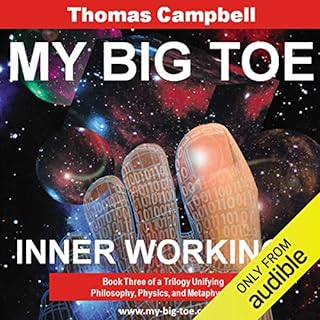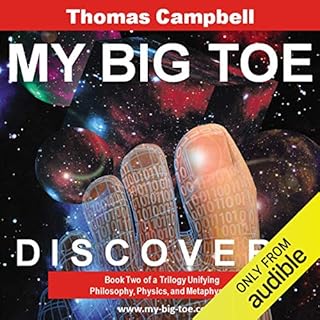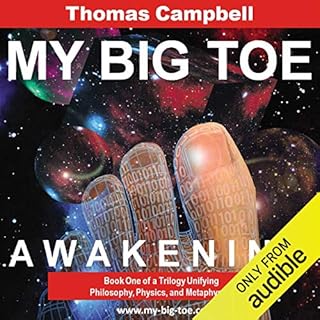Thomas
- 4
- reviews
- 8
- helpful votes
- 4
- ratings
-
The Origin of Consciousness in the Breakdown of the Bicameral Mind
- By: Julian Jaynes
- Narrated by: James Patrick Cronin
- Length: 16 hrs and 1 min
- Unabridged
-
Overall4.5 out of 5 stars 633
-
Performance4.5 out of 5 stars 540
-
Story4.5 out of 5 stars 538
At the heart of this classic, seminal book is Julian Jaynes' still-controversial thesis that human consciousness did not begin far back in animal evolution but instead is a learned process that came about only 3,000 years ago and is still developing. The implications of this revolutionary scientific paradigm extend into virtually every aspect of our psychology, our history and culture, our religion - and indeed our future.
-
5 out of 5 stars
-
An Archaelogical Expedition of Our Minds
- By Michael on 10-08-15
Psyche pronounced as see-key 44 times
Reviewed: 08-24-22
Nothing to add to the 5-star reviews about this phenomenal essay. However, for a book with the word 'MIND' in the title it's painful to hear the narrator, James Patrick Cronin, pronounce 'psyche' as 'see-key' forty-four (44) times over 26 of its 469 pages. The word psyche is used twice on page 69, once on page 71, once on page 257 and then forty (40) times beginning on page 270 under the section titled 'Psyche' through page 292. On page 291 the word 'psyche' is used nine (9) times. Here it is, read it out loud for yourself as "see-key" - - - "But the 'see-key' here is somewhat the same, a something of a man which leaves the body at death. And what the Hades view of 'see-key' may be is a composite of the Pythagorean teaching with the older view of the buried dead in Greek antiquity. All this curious development of the sixth century B.C. is extremely important for psychology. For with this wrenching of 'see-key' = life over to 'see-key' = soul, there came other changes to balance it as the enormous inner tensions of a lexicon always do. The word soma had meant corpse or deadness, the opposite of 'see-key' as livingness. So now, as 'see-key' becomes soul, so soma remains as its opposite, becoming body. And dualism, the supposed separation of soul and body, has begun. But the matter does not stop there. In Pindar, Heraclitus, and others around 500 B.C., 'see-key' and nous begin to coalesce. It is now the conscious subjective mind-space and its self that is opposed to the material body. Cults spring up about this new wonder-provoking division between 'see-key' and soma. It both excites and seems to explain the new conscious experience, thus reinforcing its very existence. The conscious 'see-key' is imprisoned in the body as in a tomb." - - - It's just atrocious. He mangles the pronunciation of other words - but this is the most prolific sputter that actually has a ruinous and detracting impact. FYI: In the book, the word 'psyche' is italicized every time. Just stunning.
Something went wrong. Please try again in a few minutes.
You voted on this review!
You reported this review!
6 people found this helpful
-
My Big TOE: Inner Workings
- Book Three of a Trilogy Unifying Philosophy, Physics, and Metaphysics
- By: Thomas Campbell
- Narrated by: Thomas Campbell
- Length: 8 hrs and 27 mins
- Unabridged
-
Overall4.5 out of 5 stars 231
-
Performance4.5 out of 5 stars 204
-
Story4.5 out of 5 stars 203
My Big TOE, written by a nuclear physicist in the language of contemporary culture, unifies science and philosophy, physics and metaphysics, mind and matter, purpose and meaning, the normal and the paranormal. The entirety of human experience (mind, body, and spirit) including both our objective and subjective worlds is brought together under one seamless scientific understanding. Section 5 presents the formal reality model in detail while Section 6 provides the wrap-up that puts everything discussed into an easily understood perspective.
-
5 out of 5 stars
-
Written out of a love for mankind . . .
- By Diana on 12-02-13
- My Big TOE: Inner Workings
- Book Three of a Trilogy Unifying Philosophy, Physics, and Metaphysics
- By: Thomas Campbell
- Narrated by: Thomas Campbell
Listening tip 4 the earnest, or begining, learner
Reviewed: 07-21-22
A similar review was left on Amazon’s site for the 3 in 1 volume of My Big Toe, the volume Tom reads from in this Audiobook series.
I’ll skip the praise, there’s enough of those reviews, and the criticism as I have none, and leave a tip for anyone taking this work on with an earnest mindset who may be intimidated or easily discouraged.
If you want to get the most out of this Audiobook, then do yourself a favor and purchase the 3 in 1 volume Tom reads from and read along with him as he reads from this volume only – not the individual part 1, 2 and 3 volumes. In listening to him as you read along there is no way you can mistake the point he’s making or misinterpret his humor. His inflections are unmistakable. Another tip is to get a High-Lighter and some Post-It-Notes, then High-Light and flag the text you want or need to. Make the 3 in 1 volume your personal reference and study guide.
In the Audiobook introduction the presenter informs the listener that he or she may find the material a challenging digest and suggests the listener uses the pause button to think about a given concept in a particular sentence and use the rewind button to hear the concept again before proceeding in order to understand the succeeding concept. That is a consumer specific tip as some who are familiar with Tom Campbell’s work on YouTube, or have digested a fair amount of like information from the hard material no “woo” physicists like Lawrence Krauss and Max Tegmark et al (he does not mention by name anyone who may have dismissed him as “woo” – these two are just an example of the main-stream academic material physicists who’ve put the “hard problem” (Which is: How does something as immaterial as consciousness arise from the material?) - into another dimension with no conclusive solution, - and have familiarity with those degreed professionals with open minds who’ve been dismissed from by the mainstream physicists as woo, such as: Bruce Lipton, Rupert Sheldrake, Nassim Haramein et al – then you may not need to pause or rewind – but with High-Lighter and page flags on hand you may be able to breeze along.
The only omission from the Audiobook, an obvious editorial oversight, starts in Book 2, Section 4, Chapter 56 on page 525 from the end of the “Aside” A similar review was left on Amazon’s site for the 3 in 1 volume of My Big Toe, the volume Tom reads from in this Audiobook series.
I’ll skip the praise, there’s enough of those reviews, and the criticism as I have none, and leave a tip for anyone taking this work on with an earnest mindset who may be intimidated or easily discouraged.
If you want to get the most out of this Audiobook, then do yourself a favor and purchase the 3 in 1 volume Tom reads from and read along with him as he reads from this volume only – not the individual part 1, 2 and 3 volumes. In listening to him as you read along there is no way you can mistake the point he’s making or misinterpret his humor. His inflections are unmistakable. Another tip is to get a High-Lighter and some Post-It-Notes, then High-Light and flag the text you want or need to. Make the 3 in 1 volume your personal reference and study guide.
In the Audiobook introduction the presenter informs the listener that he or she may find the material a challenging digest and suggests the listener uses the pause button to think about a given concept in a particular sentence and use the rewind button to hear the concept again before proceeding in order to understand the succeeding concept. That is a consumer specific tip as some who are familiar with Tom Campbell’s work on YouTube, or have digested a fair amount of like information from the hard material no “woo” physicists like Lawrence Krauss and Max Tegmark et al (he does not mention by name anyone who may have dismissed him as “woo” – these two are just an example of the main-stream academic material physicists who’ve put the “hard problem” (Which is: How does something as immaterial as consciousness arise from the material?) - into another dimension with no conclusive solution, - and have familiarity with those degreed professionals with open minds who’ve been dismissed from by the mainstream physicists as woo, such as: Bruce Lipton, Rupert Sheldrake, Nassim Haramein et al – then you may not need to pause or rewind – but with High-Lighter and page flags on hand you may be able to breeze along.
The only omission from the Audiobook, an obvious editorial oversight, starts in Book 2, Section 4, Chapter 56 on page 525 from the end of the “Aside” (see photo where marked) and all pages up to and including page 530. The Audiobook picks the text back up at the beginning of Book 2, Section 4, Chapter 57 on page 531 and is complete to the end to the end on page 820. It’s a magnificent performance on top of a masterpiece.
Something went wrong. Please try again in a few minutes.
You voted on this review!
You reported this review!
-
My Big TOE: Discovery
- Book Two of a Trilogy Unifying Philosophy, Physics, and Metaphysics
- By: Thomas Campbell
- Narrated by: Thomas Campbell
- Length: 15 hrs and 25 mins
- Unabridged
-
Overall4.5 out of 5 stars 258
-
Performance4.5 out of 5 stars 227
-
Story4.5 out of 5 stars 221
Section 3 develops the interface and interaction between we the people and our digital consciousness reality. It derives and explains the characteristics, origins, dynamics, and function of ego, love, and free will. It derives our larger purpose. Finally, Section 3 develops the psi uncertainty principle as it explains and interrelates psi phenomena, free will, love, consciousness evolution, reality, human purpose, entropy and physics.
-
5 out of 5 stars
-
A guidebook to a bigger reality & realization
- By Diana on 11-27-13
- My Big TOE: Discovery
- Book Two of a Trilogy Unifying Philosophy, Physics, and Metaphysics
- By: Thomas Campbell
- Narrated by: Thomas Campbell
Listening tip 4 the earnest, or begining, learner
Reviewed: 07-21-22
A similar review was left on Amazon’s site for the 3 in 1 volume of My Big Toe, the volume Tom reads from in this Audiobook series.
I’ll skip the praise, there’s enough of those reviews, and the criticism as I have none, and leave a tip for anyone taking this work on with an earnest mindset who may be intimidated or easily discouraged.
If you want to get the most out of this Audiobook, then do yourself a favor and purchase the 3 in 1 volume Tom reads from and read along with him as he reads from this volume only – not the individual part 1, 2 and 3 volumes. In listening to him as you read along there is no way you can mistake the point he’s making or misinterpret his humor. His inflections are unmistakable. Another tip is to get a High-Lighter and some Post-It-Notes, then High-Light and flag the text you want or need to. Make the 3 in 1 volume your personal reference and study guide.
In the Audiobook introduction the presenter informs the listener that he or she may find the material a challenging digest and suggests the listener uses the pause button to think about a given concept in a particular sentence and use the rewind button to hear the concept again before proceeding in order to understand the succeeding concept. That is a consumer specific tip as some who are familiar with Tom Campbell’s work on YouTube, or have digested a fair amount of like information from the hard material no “woo” physicists like Lawrence Krauss and Max Tegmark et al (he does not mention by name anyone who may have dismissed him as “woo” – these two are just an example of the main-stream academic material physicists who’ve put the “hard problem” (Which is: How does something as immaterial as consciousness arise from the material?) - into another dimension with no conclusive solution, - and have familiarity with those degreed professionals with open minds who’ve been dismissed from by the mainstream physicists as woo, such as: Bruce Lipton, Rupert Sheldrake, Nassim Haramein et al – then you may not need to pause or rewind – but with High-Lighter and page flags on hand you may be able to breeze along.
The only omission from the Audiobook, an obvious editorial oversight, starts in Book 2, Section 4, Chapter 56 on page 525 from the end of the “Aside” (see photo where marked) and all pages up to and including page 530. The Audiobook picks the text back up at the beginning of Book 2, Section 4, Chapter 57 on page 531 and is complete to the end to the end on page 820. It’s a magnificent performance on top of a masterpiece.
Something went wrong. Please try again in a few minutes.
You voted on this review!
You reported this review!
-
My Big TOE: Awakening
- Book One of a Trilogy Unifying Philosophy, Physics, and Metaphysics
- By: Thomas Campbell
- Narrated by: Thomas Campbell
- Length: 11 hrs and 11 mins
- Unabridged
-
Overall4.5 out of 5 stars 493
-
Performance4.5 out of 5 stars 425
-
Story4.5 out of 5 stars 420
My Big TOE: Awakening, written by a nuclear physicist in the language of contemporary culture, unifies science and philosophy, physics and metaphysics, mind and matter, purpose and meaning, the normal and the paranormal. The entirety of human experience (mind, body, and spirit) including both our objective and subjective worlds is brought together under one seamless scientific understanding.
-
2 out of 5 stars
-
What a Trip (but to where?)
- By Michael on 11-26-13
- My Big TOE: Awakening
- Book One of a Trilogy Unifying Philosophy, Physics, and Metaphysics
- By: Thomas Campbell
- Narrated by: Thomas Campbell
Listening tips for the earnest or begining learner
Reviewed: 07-21-22
A similar review was left on Amazon’s site for the 3 in 1 volume of My Big Toe, the volume Tom reads from in this Audiobook series.
I’ll skip the praise, there’s enough of those reviews, and the criticism as I have none, and leave a tip for anyone taking this work on with an earnest mindset who may be intimidated or easily discouraged.
If you want to get the most out of this Audiobook, then do yourself a favor and purchase the 3 in 1 volume Tom reads from and read along with him as he reads from this volume only – not the individual part 1, 2 and 3 volumes. In listening to him as you read along there is no way you can mistake the point he’s making or misinterpret his humor. His inflections are unmistakable. Another tip is to get a High-Lighter and some Post-It-Notes, then High-Light and flag the text you want or need to. Make the 3 in 1 volume your personal reference and study guide.
In the Audiobook introduction the presenter informs the listener that he or she may find the material a challenging digest and suggests the listener uses the pause button to think about a given concept in a particular sentence and use the rewind button to hear the concept again before proceeding in order to understand the succeeding concept. That is a consumer specific tip as some who are familiar with Tom Campbell’s work on YouTube, or have digested a fair amount of like information from the hard material no “woo” physicists like Lawrence Krauss and Max Tegmark et al (he does not mention by name anyone who may have dismissed him as “woo” – these two are just an example of the main-stream academic material physicists who’ve put the “hard problem” (Which is: How does something as immaterial as consciousness arise from the material?) - into another dimension with no conclusive solution, - and have familiarity with those degreed professionals with open minds who’ve been dismissed from by the mainstream physicists as woo, such as: Bruce Lipton, Rupert Sheldrake, Nassim Haramein et al – then you may not need to pause or rewind – but with High-Lighter and page flags on hand you may be able to breeze along.
The only omission from the Audiobook, an obvious editorial oversight, starts in Book 2, Section 4, Chapter 56 on page 525 from the end of the “Aside” (see photo where marked) and all pages up to and including page 530. The Audiobook picks the text back up at the beginning of Book 2, Section 4, Chapter 57 on page 531 and is complete to the end to the end on page 820. It’s a magnificent performance on top of a masterpiece.
Something went wrong. Please try again in a few minutes.
You voted on this review!
You reported this review!
2 people found this helpful





